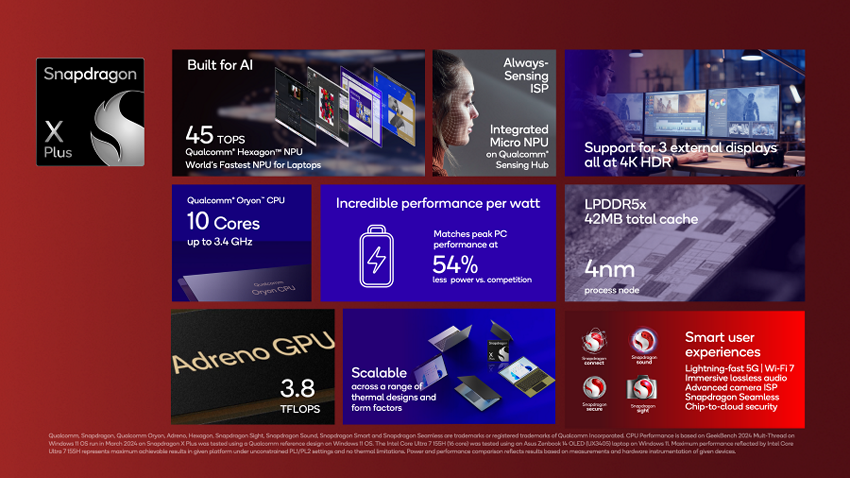Back in October, Qualcomm introduced the Snapdragon X Elite chip that aims to compete with Apple Silicon. Today the company has introduced another offering from the Snapdragon X lineup, the Snapdragon X Plus. Just as the naming suggests, it’s a more affordable and slightly less capable version of the Snapdragon X Elite. Both the chips are expected to become available to power Windows-on-Arm laptops in mid-2024.

Qualcomm emphasized on the AI capabilities of the new Snapdragon X series chips
The Snapdragon X Plus chip equips a total of 10 custom Oryon CPU cores made by Qualcomm. According to the company, the CPU delivers 37% performance improvement with 54% less power as compared to its “competitors”. However, the company didn’t describe its “competition” any further.
Another aspect Qualcomm emphasized is the chip’s capable NPU and possible performance in on-device AI-related tasks. The Snapdragon X series chips reportedly equip “the world’s fastest NPU for laptops.” The capability of the dedicated Qualcomm Hexagon NPU is measured at 45 TOPS (trillions of operations per second), which, according to the company, will offer unprecedented performance, efficiency, and on-device AI capabilities to Windows PCs.

All these on-device AI capabilities are expected to enable developers to add a variety of new and exciting features to apps that will in turn make life a lot easier. Nonetheless, it takes more than just the capable chips and we will have to wait for the implementation of features.
Qualcomm demonstrated the AI capabilities of this chip with code generation in “Visual Studio Code” from Codegen. It is a program designed to assist developers by generating new lines of code in real-time with on-device generative AI. The company also demonstrated Music generation from text prompts in Audacity and automatic language translation into live captions in OBS Studio.
The Snapdragon X Plus chip has recently appeared on the GeekBench ML listing running on a mysterious device with 16GB memory. The codename of the device suggests that it could be a Surface laptop, the Surface Pro 10.
Related:
- Get $100 OFF on Xiaomi 14 Pro at Giztop (1TB Variant)
- Lenovo Legion Y700 2024: Latest Gaming Tablet with Enhanced Display now available at Giztop
- REDMAGIC Magnetic VC Cooler 5 Pro now available at a discounted price at GeekWills
- 6 Amazing One UI 6.1 AI Features You Can’t Ignore
(Source)






